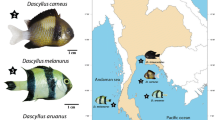Abstract
Genetic variation was examined in the Japanese apogamous and sexual forms ofAsplenium unilaterale by electrophoretic analysis of eight enzyme systems. The apogamous form consisted of four biotypes (A, B, C, and D) which show different band patterns. Biotypes C and D were distinguished from biotype A by a difference at only one locus each:Mdh-1 andPgi-2, respectively. Biotypes A, C, and D were sufficiently differentiated from the sexual form (Nei's genetic distance (D)=0.50). This suggests that the apogamous form is not directly derived from the sexual form. However, biotype B expressed the combined band pattern of biotype C and the sexual form, leading to the conclusion that biotype B probably originated by hybridization between those two.
Similar content being viewed by others
References
Gastony, G.J., andL.D. Gottlieb. 1985. Genetic variation in the homosporous fernPellaea andromedifolia. Amer. J. Bot.72: 257–267.
Grant, V. 1981. Plant Speciation. Columbia Univ. Press, New York.
Gottlieb, L.D. 1981. Electrophoretic evidence and plant populations. Prog. Phytochem.7: 1–46.
Haufler, C.H. 1985. Enzyme variability and modes of evolution in the fern genusBommeria. Syst. Bot.,10: 92–104.
Iwatsuki, K. 1975. Taxonomic studies of Pteridophyta X. Acta Phytotax. Geobot.27: 39–55.
Klekowski, E.J. 1973. Sexual and subsexual systems in the homosporous ferns: a new hypothesis. Amer. J. Bot.60: 535–544.
Kurita, S. 1960. Chromosome numbers of some Japanese ferns. J. Jap. Bot.35: 269–272 (in Japanese).
Löve, Á. 1963. Biosystematics and classification of apomicts. Feddes Rep.63: 136–149.
Mitui, K. 1975. Chromosome numbers of Japanese pteridophytes. Bull. Nippon Dental Coll. General Educ.4: 221–271.
Momose, S. 1960. The prothallia ofAspleniaceae (3). J. Jap. Bot.35: 47–54 (in Japanese).
Murakami, N. andK. Iwatsuki. 1983. Observation on the variation ofAsplenium unilaterale in Japan with special reference to apogamy. J. Jap. Bot.58: 257–262.
Soltis D.E., C.H. Haufler, D.C. Darrow, andG.J. Gastony. 1983. Starch gel electrophoresis of ferns: a compilation of grinding buffers, gel and electrode buffers, and staining schedules. Amer. Fern J.73: 9–27.
Stebbins G.L. 1950. Variation and Evolution in Plants. Columbia Univ. Press, New York.
—. 1971. Chromosomal Evolution in Higher Plants. Edward Arnold Ltd. London.
Walker, T.G. 1962. Cytology and evolution in the fern genusPteris L. Evolution16: 27–43.
Author information
Authors and Affiliations
Rights and permissions
About this article
Cite this article
Watano, Y., Iwatsuki, K. Genetic variation in the ‘Japanese apogamous form’ of the fernAsplenium unilaterale Lam.. Bot Mag Tokyo 101, 213–222 (1988). https://doi.org/10.1007/BF02488600
Received:
Accepted:
Issue Date:
DOI: https://doi.org/10.1007/BF02488600




